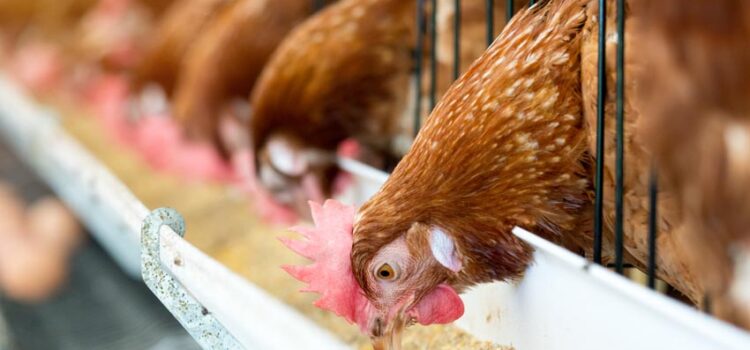Pelleting is system of a modification of the mash system by mechanically pressing the mash into hard dry pellets or “artificial grains”. It is generally accepted that, compared to mash, the feeding of pellets improves feed conversion, broiler performance with an increased feed intake.

Reasons for the enhanced performance may be due to increased digestibility, decreased ingredient segregation, Decreased feed wastage, reduction of energy during prehension and improved palatability and so the modern broiler industry has traditionally fed a pelleted diet to birds. The quality of pellets must be taken into account also because feeding pelleted rations is not enough to ensure enhanced performance of poultry but also the proper growth, immunity and health status of the bird. There are a number of excellent methods to objectively measure and record the quality of pellets during the manufacturing process.
Other disadvantages of poorly formed pellet includes:
- Dusting potential
- Flow properties and proportioning gets impaired by fines
- Remainders in silos, bins and pans will be increased by fines
- Fines and dust are preferred nutrients and habitats for germs and micro organisms of any kind
High fines in the pellet can be a menace and mainly attributed to the issues of “soft pellets” at the press. Improving pellet hardness or durability is an effective means of reducing fines. Pellet durability may be improved by manipulation of diet formulation and improving feed manufacturing practices. Feed manufacturing practices adjusted to suitable to ambient climatic conditions and native ingredients will have a profound effect on pellet durability and potentially involve less expense than changing raw materials or using pellet binders.
Further the economic aspect of moisture retention in feed processing is strongly recognized but there are several other interesting aspects attached with this moisture content of the feed as well. One of them is its consequence on keeping quality and duration for how long it stays fresh. Nothing beats a freshly cooked meal, and this holds true not only for humans, but for animals, too.
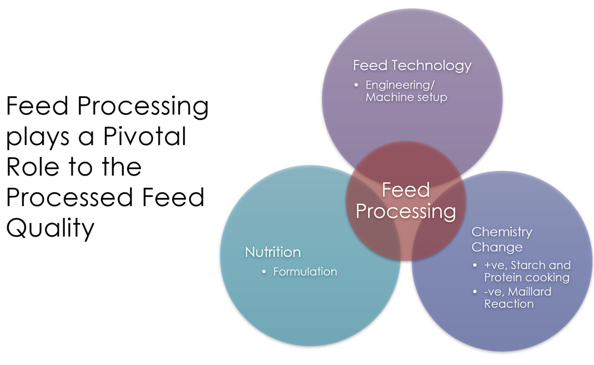
Feed components start deteriorating as soon as they undergo the feed mixing process. Feed exposed to high temperature (and) or high humidity, or feeds containing increased levels of sensitive ingredients, will have a reduced shelf life. Cooked starch starts looking “stale” as soon as it cools down, Vitamins starts loosing potency almost instantly when intermixed with certain trace minerals, fats and lipids start oxidizing as soon as they come into contact with air and this is why it is important to control water activity (aw) of feed to keep these vital nutrients intact and keep the feed remain fresh till it is consumed. It is not that feed becomes unsuitable to consume so fast but it is the significant loss of micronutrients from mixing of feed to actually consume by the hyper producing birds.
Respiratory Challenges/ Ascites:
Because of poor pellet quality and reduced hardness, fines up to 50% have been reported from the field conditions. These incidences of high levels of fines in the field are not only associated with poor live weight and FCR but also has huge dusting potential posing respiratory challenges. The fines in the feed are inhaled by the birds and while exhaling they settle in various part of air sacs, specially thoracic air sac where air stays for longer period which leads difficulty for birds to breath hence deficiency of oxygen in the blood.
Further mold spores appear almost immediately within 12-24 hours after the bagging of the feed in field conditions. The moisture content of the feed usually ranges from 10 – 12%, which when exposed to environment and retained in the pans as uneaten leftover for a week or more before it is consumed in automated feed system gets heavily contaminated with mold spores. Birds fed with lots of fines in feed with increasing mold spores infestation and placed in environments contaminated with aerosolized conidia (mold spores) may show significant pathology after only a short duration of exposure.
Anatomy and physiology of the avian lung-air sac system are strikingly different from that of the broncho-alveolar 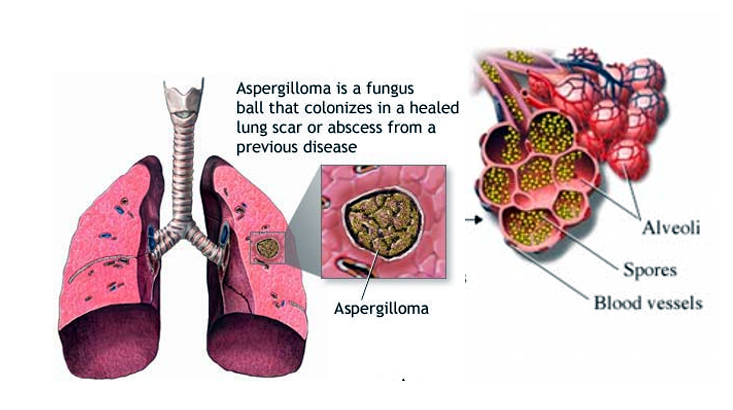 lung of mammals. Avian air sacs are particularly prone to contamination because they are submitted to an airflow that favours particle deposition. Mold spores are small enough, 2-3 μm in diameter, to bypass initial physical barriers and disseminate deeply in the respiratory system.
lung of mammals. Avian air sacs are particularly prone to contamination because they are submitted to an airflow that favours particle deposition. Mold spores are small enough, 2-3 μm in diameter, to bypass initial physical barriers and disseminate deeply in the respiratory system.
It has been suggested that the dust created by the fines of the feed and mold appeared in the stale feed 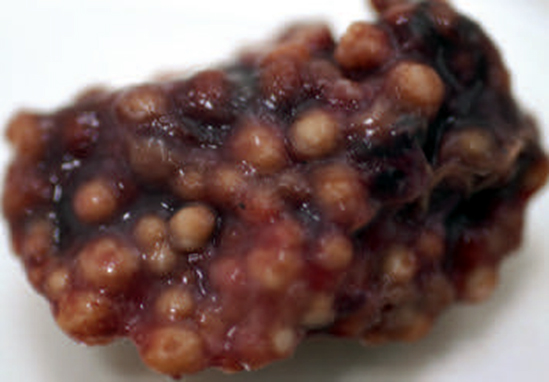 get inhaled by the birds during increased number of pecking, leading to irritation and reduced efficiency of the airways. Poor air quality, environment dust and respiratory diseases also impairs the perfusion capacity of chicken lungs, creating an imbalance between oxygen supply and the oxygen required to sustain rapid growth thus predispose birds to ascites by causing respiratory damage.
get inhaled by the birds during increased number of pecking, leading to irritation and reduced efficiency of the airways. Poor air quality, environment dust and respiratory diseases also impairs the perfusion capacity of chicken lungs, creating an imbalance between oxygen supply and the oxygen required to sustain rapid growth thus predispose birds to ascites by causing respiratory damage.
Ascites is a disease, which causes death in poultry apparently because of fluid retention. Ascites is commonly known 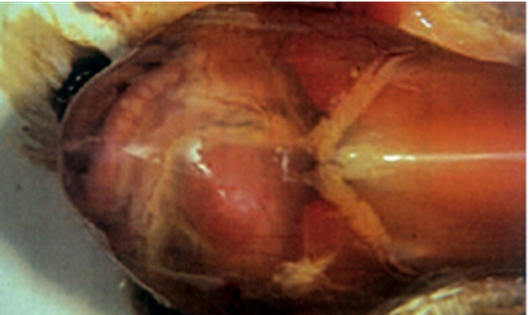 as “water belly”. There is no known cause and no apparent cure. There are theories that the amount of heat in the early days of the chicken or turkey’s life, or stress, may be the cause of ascites but there is no significant data to support these theories. However, invention with antifungal agents to reduce the symptoms associated with ascites and preventing mortality from the disease confirms the role of mold and its spores as a major causative factor for the ascites.
as “water belly”. There is no known cause and no apparent cure. There are theories that the amount of heat in the early days of the chicken or turkey’s life, or stress, may be the cause of ascites but there is no significant data to support these theories. However, invention with antifungal agents to reduce the symptoms associated with ascites and preventing mortality from the disease confirms the role of mold and its spores as a major causative factor for the ascites.
The commercial broiler of today represents the culmination of dramatic changes over the past 60 years. Genetic selection processes that focused mainly on production traits putting heavy pressure on the bird’s cardio respiratory system and immunity.
Increase in metabolic rate, coupled with exposure to environmental conditions such as temperature, lighting and ventilation, and nutritional factors such as feed form or fines into it, all seem to promote the development of ascites. The primary cause of the ascites syndrome, however, is believed to be hypoxia/hypoxemia when the bird’s demand for O2 exceeds its cardiopulmonary capacity and causes pulmonary hypertension, which results in development of the ascites syndrome. Inadequate ventilation and dusty feed increase the risk of bird exposure to aerosolized spores. Acute cases are seen in young animals following inhalation of spores, causing high morbidity and mortality. The chronic form affects older birds and looks more sporadic.
Crop Mycosis or Mycotic Diarrhea
Crop mycosis or Mycotic Diarrhea is a reference to a condition called Sour Crop that is caused by a type of yeast called Candida albicans. This causes thickening of the crop surface characterized by whitish thickened areas of the crop and proventriculus and may keep nutrients from being properly absorbed from the intestinal tract. It may lead to destroy the tissues of the upper digestive tract particularly the crop and gizzard. It is believed that in severe cases the disease may also infect the intestinal tract. Feeds and fluids may retained in the crop, causing it to enlarge. The orientation of the crop of a chicken is such that any feed or water consumed tends to flow past and contact the crop. Particularly, an environment which is warm, moist, possesses a neutral pH, contains oxygen, includes a substrate which enhances yeast growth.
Poultry of all ages are susceptible to the effects of this organism. The disease affects primarily broilers, laying hens and turkeys. Mycosis is transmitted mainly by ingestion of the moldy feed, water or environment. The organism grows especially well on corn-based diet, so infection can be introduced easily by feeding stale feed. Crop Mycosis may also be “triggered” by the use of high levels of antibiotics in feed or drinking water for treatment of other bacterial diseases like CRD, Necrotic enteritis, colibacillosis etc. Continued use of antibacterial agents in poultry to prevent and treat increasing bacterial infections often causes secondary fungal infection, giving chance to mold spores appeared in the feed during transit and storage to colonize and multiply in the crops as feed stays longest in the crop (approximately 90-100 minutes). Birds/flocks who have been on antibiotics for a period of time are the easiest target of crop mycosis, fed on caked or stale feed.
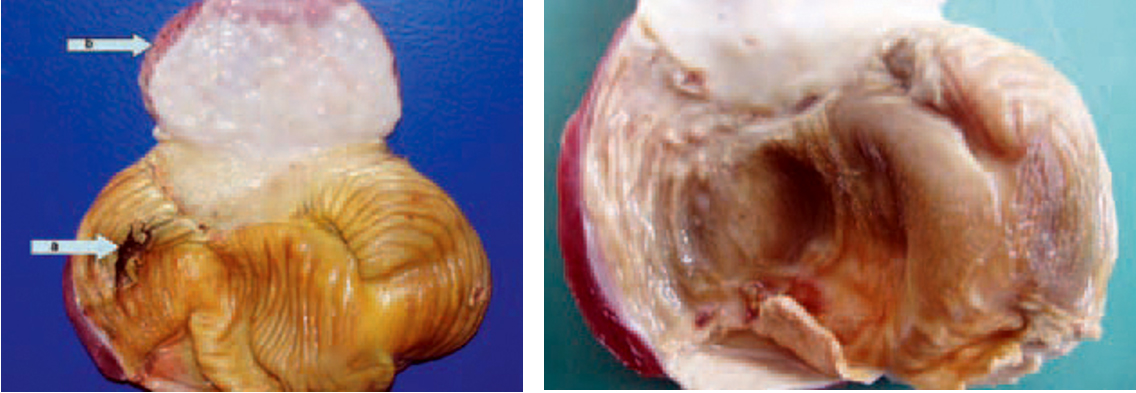
This malady produces no specific symptoms. Young chicks become listless, pale, show ruffled feathers and appear unthrifty. Affected caged layer hens become obese and anemic. Clinical signs include dull and depressed look, reduced feed intake, poor growth often with large fluid filled crops and foul smelling odor emitted around the mouth. Profuse diarrhea may be noted. Losses are due to reduced feed efficiency, increased mortality (from 5%-20%), poor performance and stunted growth. Some birds also exhibit a vent inflammation that resembles a diarrhea-induced condition having whitish incrustations of the feathers and skin around the area. Feed consumption may increase by 10% to 20%.
Diagnosis is based upon clinical signs and relevant history. Gross lesions are mostly confined to the crop, proventriculus and gizzard. The crop and proventriculus have whitish thickened areas that are often described as having a “turkish towel” appearance.
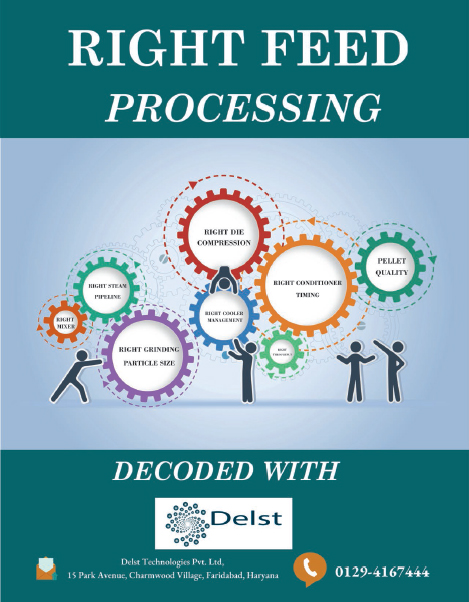
Erosion of the lining of the proventriculus and gizzard is commonly observed, as well as an inflammation of the intestines. Mycotic lesions in young poults and chicks may be so small as to be easily over- looked during postmortem examination. Additional tests such as crop histopathology or microscopic examination of crop smears (mixed with KOH 10% and heated) will diagnose if Fungi is the cause however are rarely done due to time and financial constraints.
Once introduced into the flock, mold/yeast is perpetuated by suboptimal management conditions. Preventative measures include the continual use of a feed preservative & mold inhibitors in the feed, proper feed handling and storage, daily cleaning and sanitizing of the watering system.
Mycotoxins & Toxicity:
Mycotoxins are often accumulated in the feed dust as they offer a very favourable condition for mold and fungus to grow and exposure to it can have toxic effects on all farms animals including Poultry. Consumption of mycotoxins-contaminated feed causes a plethora of harmful responses from acute toxicity to many persistent health disorders with lethal outcomes. Effects of a mycotoxin on poultry depend on the mycotoxin type, level and duration of exposure and age. Acute toxicity is caused by intake of high doses of mycotoxins and is characterized by death and well-described clinical signs. Most prevalent Aflatoxins are reported to cause reduced bird performance, lower immunity, organ damage, and reduced egg production. Therefore, the main task for feed producers is not only to carefully select raw materials based on the nutritional quality, safety, price, and availability but to also minimize the concentration of mycotoxin in formulated final feed by applying right processing knowledge and strategies aimed at minimizing the risk of fines in final bagging and mycotoxin effects on animals and human health. Challenging climatic conditions characterized by high relative humidity, high temperatures, and more free water in the final feed aggravate the mycotoxins biosynthesis by toxigenic fungi in the feed with high fines percentage.
Conclusion:
Although improved broiler performance is an advantage for pellet feeding, some disadvantages seem to be connected to feeding poor quality pellets to the birds. With respect to animal health, a correlation between poor quality pellet feeding with lots of fines in it and the occurrence of certain diseases cannot be ignored. Nutritionist plays an important role in poultry industry to achieve the genetic potential of these hyper performing birds. As the industry has always been working from a feed formulation perspective and Nutritionist’s and feed manufacturers spend much time and effort in evaluating the formulation, and feed additives but the final pellet quality.
It is important to realize here that feeding low quality pellets or crumble to the “new and improved” poultry can potentially do irreversible damage. Since poultry have the highest rate of gain early in life, they need nutrient-dense diets that support the rapid growth rate without challenging their health status. Feeding for least cost without focusing quality of crumbles and pellet in the first two weeks can result in lost performance that is never regained.
Not only is a proper nutritional program critical, but also a strong quality control program is a must to assure that quality ingredients are received and high-quality feed produced. This is as important for macro-ingredients such as corn, soybean, fat and animal proteins sources as it is for micro-ingredients such as vitamins, amino acids and trace minerals. It is also crucial to ensure that the feed mill delivers durable pellets and crumbles with a minimum amount of fines to encourage feed consumption.

Properly formulated feeds are worthless if birds do not eat the feed as a complete meal packet (a pellet or crumble). Finally, as the number of disease outbreaks are on rise and use of antibiotics for bacterial challenges is becoming limited, it is important for the vets as well to explore alternative options to keep the feed fresh and pathogen free to offset disease challenges.
Feed formulation no doubt is the focus point of this business, but raw material handling and feed processing plays a huge part on feed quality, and hence the performance & bottom line. A correct and pro-active approach will help save the industry much monies from unnecessary wastage from raw material quality, contamination, the unnecessary use of feed additives, over-formulation to compensate for the nutrient loss in feed processing and post processing quality issues, plus the avoidable use of medications at farm level. Controlling water activity (aw) values of the poultry feed, within safer limit, could be an extremely important consideration, in order to produce a safe and hygienic feed that is both commercially viable and since it plays an effective role in the physical, chemical and biological stability of the product.
About the author:
Dr Naveen Kumar, B.V.Sc & A.H (Gold Medalist), M.V.Sc (IVRI, Bareilly) is a food & oil seed grains storage specialist and a finished feed quality expert for Asian and other tropical countries. He also Business Director of Delst Asia and is located in Faridabad, India. He can be reached at naveensharma21@gmail.com, Mobile +91 93502 89123.
Title Image Source: BG-Studio Shutterstock.com
Another article by author: Introducing Water Activity As A Measure For Feed Quality Control (Part 1)



